Pseudonaja textilis

An Eastern Brown Snake

An eastern Brown Snake

An Eastern Brown Snake

An Eastern Brown Snake
The Eastern Brown Snake is an Elapid native to Eastern Australia. They have been known to grow up to 2.4 m long but most commonly around the 1.5m mark. The northern variety tend to get larger than our southern ones. They are most commonly brown or a shade of grey, but have been known to be jet black as well. The Eastern Brown Snake is found in most habitats except dense forests. Its main source of food is the house mouse, so with the ever-growing amount of farm land and urban sprawl, they are being spotted more regularly around our country towns and cities such as Ballarat, Ararat, Maryborough, Bendigo, Beaufort, Skipton, Avoca, Elmhurst, Stawell, Glenlofty, Warrak, Buangor, Ballan, Daylesford, Hepburn Springs, Clunes, Talbot, Lexton, Snake Valley, Creswick, Miners Rest, Redbank, Stuart Mill, St Arnaud, laanecoorie and other places that are being more heavily developed.
The Eastern Brown Snake is the world's second-most venomous land snake after the Inland Taipan (also native to Australia but not to our region). It is responsible for 60% of snake-bite deaths in Australia. It also has smaller fangs than other Australian Venomous snakes.
Juveniles can vary in markings, but generally have a black head, with a lighter brown body. They can sometimes be mistaken for whip snakes that are a small snake in Victoria which are a light brown with a black head
Large eastern brown snakes are often confused with Mulga Snakes, whose habitat they share in many areas, but may be distinguished by their smaller heads
The Eastern Brown Snake is found along the east coast of Australia, from far north Queensland, all the way down to the Mornington Peninsular at the bottom of Victoria. The Eastern Brown Snake has a large variety of habitats, ranging from dry Eucalypt forests like the ones found around the Grampians and Pyrenees Ranges, to woodlands, grass and scrublands and open fields and farmland. Their diet is mainly rodents so are less common around rainforests, but they do also eat small birds and other reptiles like Skinks. They commonly find shelter around rocks, logs, burrows and can be found under piles of building materials such as roofing tin and firewood.
The eastern brown snake is solitary, Even after the babies are born the mother generally will leave them to fend for themselves. Snakes don’t generally have maternal instincts. Like other snakes they are mostly active during the day. But in the peak of summer when the temperature can get as high as mid 40’s they may actually come out during the evening. They can even be seen in the late autumn and winter seasons if the weather is kind. They have been seen in temperatures as low as 14 °C, as long as the sun is out.
Eastern brown snakes generally mate from early October through to the end of spring, just when they are coming out of their Brumation. The eggs are laid in a sheltered, warm location such as a rabbit burrow or tree stump. Depending on the temperature and humidity the eggs can hatch anywhere from 95 days to just 36 days.
